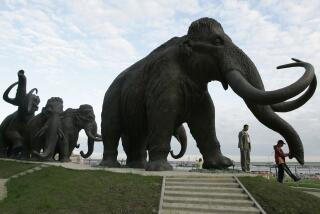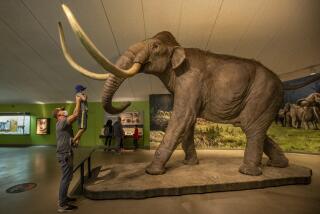Science / Medicine : Mammal Evolution Reborn in Disaster : End of the Dinosaurs
If Earth’s close encounter with a half-mile-wide asteroid recently gave you a scare, astronomers and geologists can sympathize. They know only too well what devastation a direct hit can wreak.
Yet ironically, we probably owe our very existence to just such an impact. Scientists have at last concluded a 10-year debate over what caused the global catastrophe that wiped out perhaps two-thirds of all living species 66 million years ago.
The event destroyed the last of the dinosaurs, but it also restarted the stalled evolution of our ancestors, the early mammals. The agent of destruction seems to have been a six-mile-wide asteroid or comet striking the Earth at a still undiscovered location at something like 40,000 m.p.h.
The public, however, has not gotten the message yet. Leaning over backward to appear evenhanded, the news media portray opposing camps of equally credible scientists still slugging it out over whether the catastrophe was the aftermath of a large impact or solely a huge volcanic eruption.
In reality, volcano advocates remain a tiny minority, and the evidence is solidly on the side of an impact.
Specialists recognize 120 impact craters around the world, including Meteor Crater in Arizona. (If March’s near-miss had been a hit, it would have left a crater the size of the District of Columbia.)
Before the Apollo landings began in 1969, the pockmarked face of the moon looked to some geologists like a field of collapsed volcanoes. Now no one questions that they are virtually all impact craters. Space probes have in fact revealed that the entire solar system has been battered.
Earth still suffers a slow but steady pummeling. The solar system is aswarm with potentially lethal asteroids and comets that ensure random but inevitable collisions with Earth.
Eugene Shoemaker of the U.S. Geological Survey estimates that an object six miles in diameter slams into Earth on average every 100 million years. Traveling at 43,000 m.p.h., such an impact would release 60 million megatons of energy in an instant and create a crater 90 miles wide. The aftermath--including the darkness and cold of a planet-girdling shroud of dust, whole continents in flame and acid rain--might spell doom for life on Earth.
Many researchers believe that they have found the debris from such a huge impact at the instant of geologic time that marks the end of the age of the dinosaurs 66 million years ago.
The first clue was enhanced concentrations of the element iridium laid down on top of the sediments of the 80-million-year slice of geologic time called the Cretaceous Period (abbreviated K to avoid confusion with other periods starting with C) and beneath those of the 64-million-year Tertiary Period--that is, at the K-T boundary, an instant in geologic time recorded in a fraction of an inch of sediment.
Iridium is scarce in crustal rocks but abundant in comets and asteroids. So the original framers of the impact hypothesis (the late Nobel laureate Luis Alvarez, his son Walter of UC Berkeley, and Frank Asaro and Helen Michel of the Lawrence Berkeley Laboratory) assumed that the excess iridium that they had found in 1978 at the K-T boundary came from an asteroid.
Evidence of an impact 66 million years ago has since mushroomed. Enhanced iridium at the K-T boundary is found at about 150 sites spread around the world. Other signs of impact are found in the same layer.
But the crux of the impact argument has become the presence at the boundary of shocked quartz, grains of the mineral shot through with a regular pattern of thin layers called lamellae in which crystalline quartz has been turned to glass.
Such intersecting, multiple-shock lamellae have been found only in minerals from known impact sites, nuclear test sites, laboratory shock experiments and the K-T boundary. No volcano is known to have shocked any minerals that way.
Peter Lipman of the U.S. Geological Survey, a volcanologist who had not become involved in the impact-volcano debate, noted at a conference on global catastrophes last fall in Snowbird, Utah, that he had been looking at volcanic minerals for 25 years and “we just don’t see this kind of thing. I don’t see how you can do it with a volcano.”
Nonetheless, a small group of scientists contends that a volcano could--in fact, did--generate the shocked quartz found at the K-T boundary. Physicist Alan Rice of the University of Colorado has published a theory for the generation of high shock pressures within exploding volcanoes, but the idea is roundly rejected by a variety of experts.
Shock generation requires a detonation, they argue, similar to dynamite, whereas a volcano decompresses the way a ruptured boiler does. Any mechanism that supposedly creates a volcanic shock, Shoemaker claimed, is “a mythical beast, a unicorn.”
Many paleontologists shy away from catastrophism--saying, in effect, “Fine. Kill off all the species you want with an impact, but do not include my favorite. It died out before the boundary.” The mass extinction was largely gradual, they say, not catastrophic.
The perceived suddenness of the K-T extinctions would seem to depend at times on the size of the fossil that paleontologists are considering. Pollen of western North America took a sudden drop in abundance at the iridium layer when fern spores suddenly jumped in abundance.
That looked pretty catastrophic. But eight years ago paleontologist Leo Hickey of Yale University argued that study of 1,000 leaf fossils revealed no catastrophe at the boundary. The plants did fine if these large fossils were any measure, he claimed.
But by last fall’s conference, he had reconsidered. Ten thousand newly collected leaf fossils show a dramatic extinction event at the boundary, he and colleague Kirk Johnson said. Likewise, it seems that the extinction of the spiraled, snail-like marine creatures called ammonites occurred near the boundary.
Dinosaurs were a good deal less numerous than leaves, so their remains are far rarer. No dinosaur fossil skeleton has been found closer than about two yards below the K-T boundary.
Taken literally, the two-yard gap would mean that the last dinosaur, after its race had ruled for more than 160 million years, died out mere tens of thousands of years before the impact. Consequently, some paleontologists argue that gradual changes, perhaps a retreating sea and a cooling climate, pushed the dinosaurs to extinction geologic moments before any impact.
Others contend the opposite: Because only a tiny fraction of all the buried dinosaur bones has ever been discovered, it is extremely unlikely that the ones found two yards below the K-T boundary were from the very last dinosaur on Earth.
But those remains do provide a starting point for pinning down the creatures’ disappearance. The late Luis Alvarez, using statistical techniques to extrapolate to the extinction, argued that the observed two-yard gap is just the right size if an impact did in the dinosaurs at the iridium-marked boundary.
Could fate be so cruel as to confuse the issue by a near, but totally random, coincidence? Many non-paleontologists think not. Just what proportion of the extinctions near the K-T boundary will finally end up precisely at the boundary is unclear, but there are enough there or heading that way to make the K-T impact a lethal one indeed.
Paleontologist Stephen Jay Gould of Harvard University closed the Snowbird conference by providing his view of what role an impact might have played in the evolution of life. Such catastrophic extinctions, he said, would change the rules of Darwinian evolution governing who is most fit to survive and who becomes extinct.
If the pattern is not determined by adaptation to a slowly changing environment, he said, “then I think Darwin is in trouble.” In a world subject to occasional catastrophes, humans’ ancestors--the small, reptile-like mammals--might not have survived the K-T catastrophe because of some commendable adaptation that we carry still.
Instead, their saving grace may have been some attribute--such as their small size that could have allowed burrowing out of harm’s way--that only became a decisive advantage during the moment of the catastrophe.
“The history of life,” Gould said, “is enormously more quirky than we imagined.”






